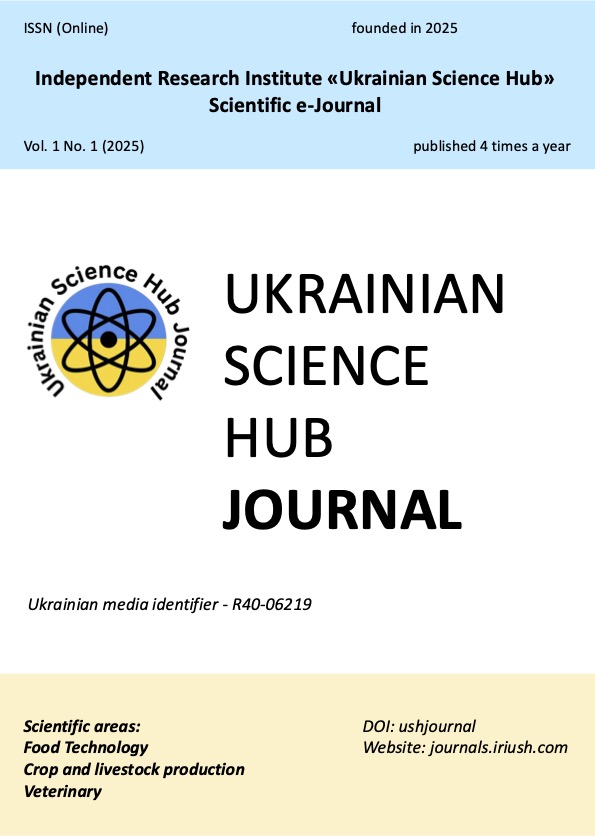HACCP-BASED FOOD SAFETY ENHANCEMENT IN SUPERMARKETS WITH IN-HOUSE PROCESSING
DOI:
https://doi.org/10.64378/iriush.journals.2025.1.3Keywords:
Retail, Critical Control Points, Risk Management, ISO 22000, Culinary Workshops, Quality Control SystemAbstract
In the context of globalization of the food industry and growing consumer demands for product quality and safety, the implementation of food safety management systems and HACCP principles is of particular importance. For retail enterprises with in-house production, this issue is critical, as they combine both production and direct sale of ready-to-eat products. The absence of proper control at any stage of the technological process may lead to serious risks for consumer health. The purpose of this study was to develop and test HACCP elements in a supermarket with its own culinary production. The research applied an analysis of the culinary workshop production process using flowcharts, the “decision tree” method for identifying critical co trol points (CCPs), risk assessment by probability and consequences, as well as document analysis of national and international regulatory frameworks (ISO 22000:2018, Codex Alimentarius, and Ukrainian legislation). Four main CCPs were identified: raw material reception, heat treatment, cooling, and storage/sale of finished products. For each CCP, HACCP worksheets were developed specifying critical limits, monitoring methods, responsible personnel, and corrective action algorithms. The proposed measures minimize biological, chemical, and physical hazards, providing a practical foundation for adapting the system to retail conditions. The developed HACCP elements proved effective as a tool for improving product safety and consumer trust. Implementing such approaches in supermarkets with in-house production ensures compliance with international standards, reduces the risk of foodborne illnesses, and strengthens the competitive position of enterprises in both domestic and international markets.
References
Bezruchenkov, Y. V. (2021). HACCP systems in hotel and restaurant establishments. Retrieved from https://dspace.luguniv.edu.ua/xmlui/bitstream/handle/123456789/8002/2021.pdf?sequence=1&isAllowed=y.
Boulfoul, N., & Brabez, F. (2022). Implementation of Food Safety Management in the Food Industry in Algeria: Benefits and Barriers Factors. Turkish Journal of Agriculture – Food Science and Technology, 10(8), 1342–1351. https://doi.org/10.24925/turjaf.v10i8.1342-1351.4741.
Budiyono, B. (2022). An analysis of implementation of food safety management ISO 22000:2005 at pt aero prima food service surakarta. International Journal of Economics, Business and Accounting Research (IJEBAR), 6(3), 2156–2168. https://doi.org/10.29040/ijebar.v6i3.6694.
Dima, A., Radu, E., & Dobrin, C. (2024). Exploring Key Barriers of HACCP Certification Adoption in the Meat Industry: A Decision-Making Trial and Evaluation Laboratory Approach. Foods, 13(9), 1303. https://doi.org/10.3390/foods13091303.
Dzwolak, W., & Anim, B. (2025). Barriers hindering maintenance of standardised HACCP-based food safety management systems in small Polish food businesses. Food Control, 168, 110849. https://doi.org/10.1016/j.foodcont.2024.110849.
Griffith, C. J., Livesey, K. M., Clayton, D. A. (2010). Food safety culture: the evolution of an emerging risk factor. British Food Journal, 112, 426–438. https://doi.org/10.1108/00070701011034439.
Grynevych, N., Dyman, T., Prisyazhnyuk, N., Sliusarenko, A., Khomiak, O., Mikhalskii, O. (2019). State of Implementation of Food Safety Management Systems at Aquaculture Enterprises. Retrieved from http://rep.btsau.edu.ua/handle/BNAU/3022.
Ivanishcheva, O., & Pakhomska, O. (2020). Peculiarities of Haccp System Implementation at Meat Processing Enterprises of Ukraine. Young Scientist, 9 (85), 98-101. https://doi.org/10.32839/2304-5809/2020-9-85-23.
Kucher, L., Knіaz S., Pavlenko, O., Yavorska, N., Dzvonyk, V., Rozmaryna, A., & Yuzva, I. (2021). State and Prospects of Ukraine’s Implementation of HACCP to Implement EU Directives on Food Safety. European Journal of Sustainable Development, 10(3), 316.
Law of Ukraine No. 771/97-VR (2025) “On Basic Principles and Requirements for Food Safety and Quality”. https://zakon.rada.gov.ua/laws/show/771/97-вр#Text .
Lozova, T. M. (2021). Food safety management (HACCP) at retail trade enterprises. Herald of Lviv University of Trade and Economics. Technical sciences, No. 25 (2021). https://doi.org/10.36477/2522-1221-2021-25-19.
Machira, F. W., & Chege, D. P. (2025). Supplier Relationship Management and Performance of Supermarkets in Nairobi County, Kenya. Journal of Procurement &Amp; Supply Chain, 5(2), 17–32. https://doi.org/10.70619/vol5iss2pp17-32/.
McSwane, D., & Linton, R. (2000). Issues and Concerns in HACCP Development and Implementation for Retail Food Operations. Journal of Environmental health, 62(6).
Order of the Ministry of Agrarian Policy and Food of Ukraine No. 590 (2015). https://zakon.rada.gov.ua/laws/show/z1704-12#Text.
Quispe, K. S., & Silva-Jaimes, M. I. (2023). Barriers and difficulties for the implementatios of HCC systems in food companies in Lima, Perú. Ingeniería Industrial, (44), 83-107.
Reimers, F. (1994). HACCP in retail food stores. Food Control, 5(3), 176-180. https://doi.org/10.1016/0956-7135(94)90079-5
Ricci, A., Chemaly, M., Davies, R., Fernández Escámez, P. S., Girones, R., ... & Bolton, D. (2017). Hazard analysis approaches for certain small retail establishments in view of the application of their food safety management systems. EFSA Journal, 15(3), e04697. https://doi.org/10.2903/j.efsa.2017.4697.
Rusavska, V., & Taran, M. (2021). Introduction of Food Safety Management System on The Basis of HACCP Principles as an Effective Method of Conquering Competitive Positions in the Market of Goods and Services for Restaurant Business Institutions. Entrepreneurship and Trade, (31), 47-54. https://doi.org/10.36477/2522-1256-2021-31-07.
Snyder, J. R. (2000). HACCP in Retail Operations Integrating FDA Fisheries, USDA, FDA Industrial, and FDA Retail HACCP Into One Set of Retail Food Industry Self‐Control Requirements. Foodservice Research International, 12(2), 119-139. https://doi.org/10.1111/j.1745-4506.2000.tb00009.x
Tiurikova, I. S., Svetashov, V. M. (2025). Features of organization of work on the development of the HACCP system in the production of flexible packaging. Modern engineering and innovative technologies, Issue №37, Part 1. https://doi.org/10.30890/2567-5273.2025-37-01.
Tkachenko, A., Sutkоvich, T., Goryachova, O., Sokil, A., Kovalchuk, Kh. (2019). Scientific substantiation of HACCP system implementation in juice production. Scientific Bulletin of Poltava University of Economics and Trade. Series "Economic Sciences", № 1 (91). http://doi.org/10.37734/2518-7171-2019-1-11.
Tsitsifli, S., Tsoukalas, D. S. (2021). Water Safety Plans and HACCP implementation in water utilities around the world: benefits, drawbacks and critical success factors. Environ Sci Pollut Res 28, 18837–18849 https://doi.org/10.1007/s11356-019-07312-2.
Wallace, C. A., Holyoak, L., Powell, S. C., Dykes, F. C. (2014). HACCP – the difficulty with hazard analysis. Food Control, 35, 233–240. https://doi.org/10.1016/j.foodcont.2013.07.012.
Wei, Y.-P. (2021). The Effect of Food Safety-Related Attributes on Customer Satisfaction of Ready-to-Eat Foods at Hypermarkets. Sustainability, 13(19), 10554. https://doi.org/10.3390/su131910554.
Downloads
Published
Issue
Section
License

This work is licensed under a Creative Commons Attribution-NonCommercial-ShareAlike 4.0 International License.


